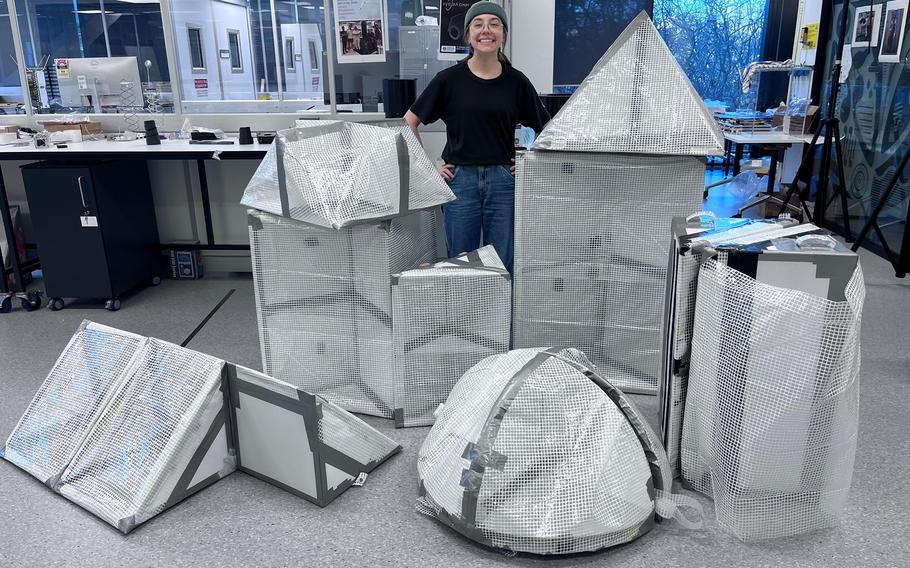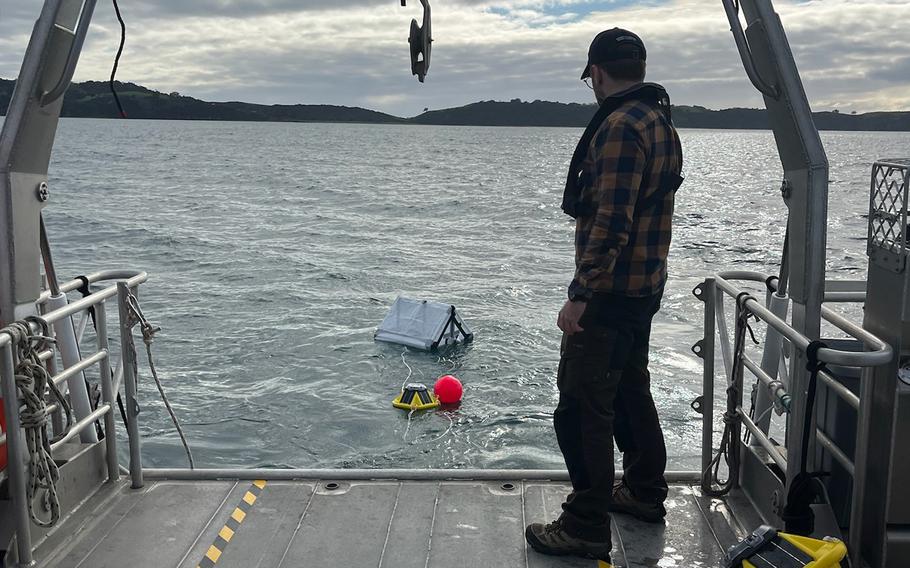
Lead engineer Ella Fascinana poses with prototype floating reflectors at the University of Auckland, New Zealand, in this undated photograph. (Tom Dowling)
New Zealand scientists are working with the U.S. Indo-Pacific Command to develop floating reflectors that can be detected from space as a low-cost alternative to maritime rescue beacons, according to the researcher leading the project.
The plastic and aluminium reflectors are the work of a team led by Tom Dowling, a University of Auckland scientist and former Royal Navy sailor.
The $20-$30 devices could be a low-cost alternative to $300 satellite locator beacons the U.S. Coast Guard encourages mariners to carry in the Indo-Pacific, Dowling told Stars and Stripes by phone Friday.
The U.S. Coast Guard frequently credits the electronic beacons — which emit a 406 MHz signal — for speedy rescues.
In May, for example, a Coast Guard HC-130 Hercules aircraft located the disabled Lucky Harvest, a 47-foot vessel, within hours of the boat’s crew activating a beacon, according to Chief Warrant Officer Sara Muir, spokeswoman for Coast Guard Forces Micronesia Sector Guam.

University of Auckland researcher Tom Dowling checks a floating reflector during recent testing near Omaha, New Zealand. (New Zealand Defence Force)
However, the beacons’ cost and maintenance needs means Indo-Pacific mariners do not often carry them, Dowling said.
The idea for reflectors, visible to a growing fleet of low Earth orbit satellites, came from an INDOPACOM conference; the research effort started 18 months ago, he said.
The effort has involved INDOPACOM, the New Zealand and Canadian militaries and European satellite operators, he said.
An INDOPACOM spokeswoman, Navy Lt. Cmdr. Chloe Morgan, had no information immediately available about the command’s involvement in the project, she said by phone after hours Thursday in Hawaii.
The innovation could be especially relevant for parts of the Pacific where people rely on simple boats, David Galligan, the director of the New Zealand Defence Force’s scientific arm, said in a defence force news release Thursday.
“The ocean is central to the lives of Pacific Island communities; it is an important source of food, and a means of transport,” he said. “But fishers often go to sea with limited safety and communications equipment. When problems arise, they can find themselves adrift on the open ocean.”
In tests staged from the New Zealand navy’s multi-role vessel HMNZS Canterbury near the subantarctic Campbell Island, the reflectors were visible to satellites in stormy seas with gusts of 50-knot winds, according to the release.
The reflectors require no batteries or maintenance and could help a country such as New Zealand, which keeps watch over a search-and-rescue region of more than 11 million square miles, according to the release.
Working at the University of Auckland’s Space Institute the researchers created prototypes with a variety of shapes — square, diamond, wedge — from materials available at home improvement stores: aluminium foil, plastic sheeting, gaffer tape and tarpaulins, the release states.
Researchers have been testing the reflectors, which can float tethered to a vessel, north of Auckland, New Zealand, in recent days, Dowling said.
They want to use artificial intelligence to identify the beacons when a satellite scans a vast area of the Indo-Pacific. That information would enable another satellite to focus on areas of interest before aircraft or vessels are dispatched to investigate, Dowling said.
“The fundamental goal is to save lives at sea,” he said.